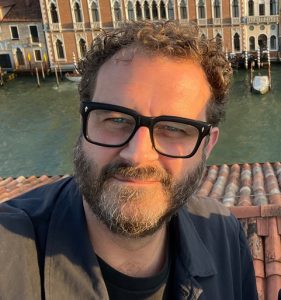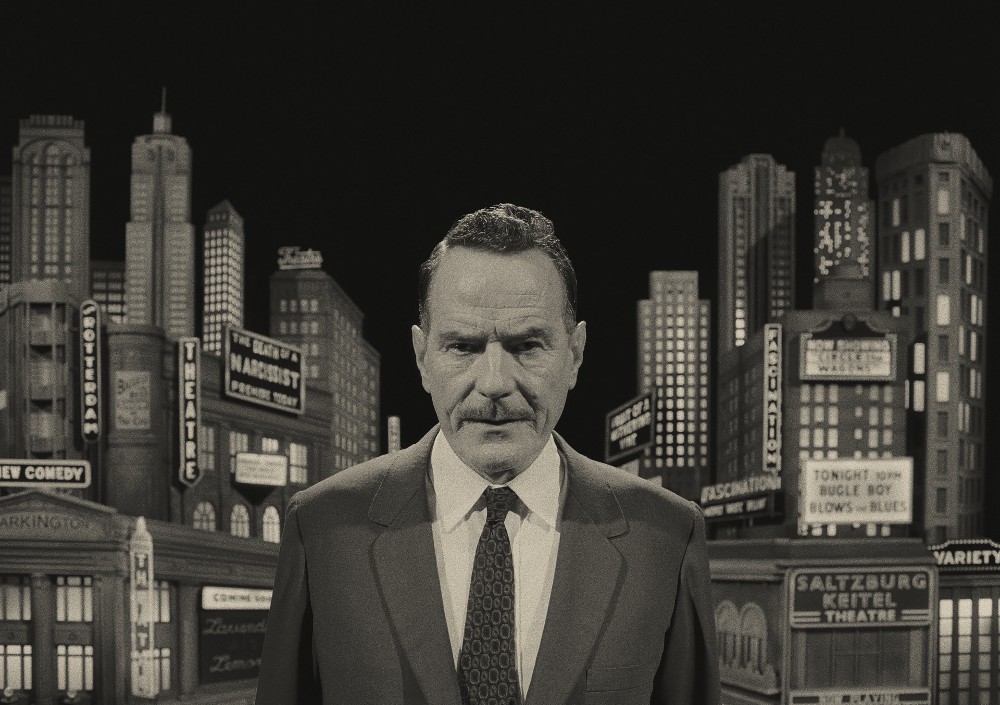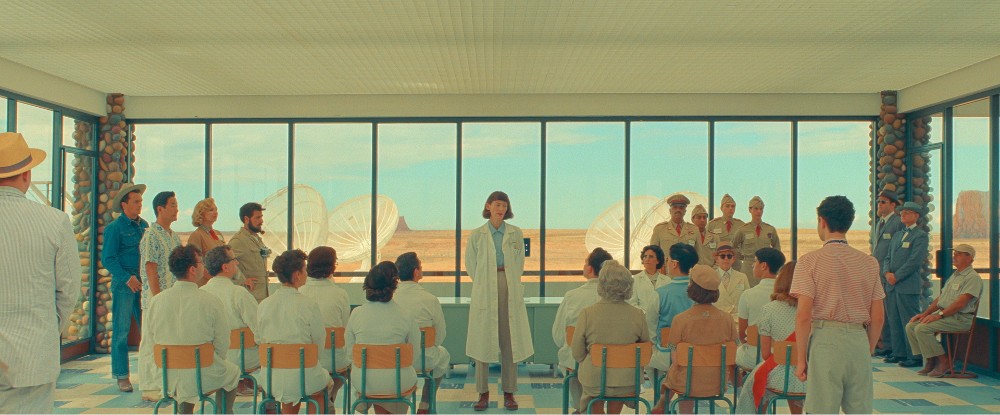
The latest Wes Anderson feature film, Asteroid City, boasts a stacked ensemble of the auteur’s regulars and a handful of new faces making their first appearance in one of his wildly imaginative projects. The end result is a dizzying display of talent, an even more impressive feat given the fact that many of those actors weren’t actually on set together for most of their scenes.
Below the Line spoke with editor Barney Pilling, who returned to work with Anderson after The Grand Budapest Hotel, about the intense and exciting opportunity of editing together material as it came to him based on the often-conflicting schedules of the actors. He also detailed how the process continued with Anderson as they collaborated on several short films adapting Roald Dahl’s work for Netflix.
While Pilling is effusive about the idea of getting to work with Anderson again, he’s also had the chance to join other talented filmmakers like Alex Garland and Ralph Fiennes on past projects, and he enjoyed the opportunity to revisit those works and one remarkably underrated TV series he hasn’t been asked about since it aired over a decade ago.

Below The Line: There are multiple stories going on in Asteroid City. How were things shot, and how did footage come to you?
Barney Pilling: It was a complete harlequin of stuff. It wasn’t chronological at all. I don’t know if you know the timeline of when we started this, but it was right after COVID. We’re just coming out of a strike, so there are certain similarities to how it feels right now to how it felt then, but certainly one of the biggest issues that Wes was dealing with when he finally got the green light and was like, yeah, okay, can go ahead and we can make this movie now because COVID is over, was actors’ availability. I think, even on a movie with a compact cast, that would have been a challenge, but on a Wes movie, of course, he’s got a good few numbers of the top ten busiest, greatest actors of this generation all wanting to come and work with him on this film.
So we had massive schedule issues with cast, and that meant that the footage that I received was very far from chronological, and also very far from complete because there were quite a number of scenes, important scenes, big chunks of the movie in fact, where we didn’t have both of the key actors in Spain at the same time. So a lot of what you see in the film has been shot twice. Once with, say, Scarlett and Jason, they kept their availability together as much as they could because their scenes were the emotional heart of the movie.
The over-the-shoulders and the synergy of what those two did on set forms the beating heart of the emotion of the film. But there were many actors that just weren’t on set because of scheduling together. We almost made two movies in that regard, just in terms of, okay, we shoot it because we have Scarlett, but we don’t have Tom Hanks. We’ll marry the two together when we have everything. It was schizophrenic. We’d shoot stuff completely out of order, and then we’d shoot parts of it again later with the actor that we actually wanted to be in the scene.
BTL: I also think it’s so interesting how a lot of Wes’ movies play with space. The camera keeps going from room to room to room. And in some cases, the actors weren’t even there.
Pilling: That’s an interesting point. The camera does move incredibly. That’s what he does. He chooses his camera team well because he knows that his narrative style is those big dolly moves. You may watch some of the big dollies in the movie, and some of them, some chunks of them, were shot weeks apart. The first part of the dolly move may have been shot in August when we first got there, and the middle section may have been shot in October because that’s when we had those actors. Even within one shot, we’re spanning months and different actors’ availability in there.
BTL: Do you ever feel like you’re physically splicing reels together and not using new advanced technology?
Pilling: Yeah, absolutely. I think it’s a key part of what Wes tries to do. You know, he’s a film historian. He loves film, shoots on film. He is keeping alive many archaic aspects of filmmaking that not many filmmakers are still using. His stop-motion animation, a link back to the great Harryhausen films that we all know and love from the day. We don’t have motion control, it is just some guys pushing a dolly, so it’s not like we can repeat digitally the moves that we’re doing with all these elaborate camera moves. So it definitely feels like that. It’s like Heath Robinson filmmaking. He’s the master of the poor man’s process in that regard.

BTL: You worked together on The Grand Budapest Hotel. How was that experience different from this one?
Pilling: Not massively different, the only difference being that Grand Budapest was the first time I’d worked with Wes. I’d been a huge fan for many years and was very lucky to be given the job to do that, and it was eye-opening from the get-go in terms of just how unique a style he has. It shouldn’t have been that much of a leap for my imagination to think that you watch these movies and of course, they’re singular, they’re unique, and they have a very specific voice. That becomes the foundation of how these things are made.
They were made in a completely different way to anything I’ve ever experienced before. I realized then, oh wow, Wes has a metronome and a methodology and a voice that I’ve never seen before. The difference between Grand Budapest and Asteroid City, although I had done some editing, I helped out for a good couple of months on Isle of Dogs, which was stop-motion animation of course, which is its own different technique in and of itself, but just the advancement of how much play we’re going to have within an individual frame between those two films had increased tenfold.
BTL: You also worked with Wes on some shorts that are now available on Netflix. Is there as much work involved in making a Wes Anderson short as a Wes Anderson feature, or any other normal feature?
Pilling: I think so, yeah. Wes is Wes. The problem that we had with the Henry Sugar shorts, the Roald Dahl pieces for Netflix was that, again, because of scheduling and just because that’s how it fell off the wagon, we made them concurrently, pretty much. We spent probably nine weeks after principal photography finished on Asteroid City putting Asteroid City together and, within that time, he was prepping, and Adam Stockhausen had moved to the UK and had built all the sets for Henry Sugar.
All of this work to set up the Netflix films had been going on whilst Wes and I were deep in fine cut for Asteroid City. We didn’t actually even really have time to sit down and watch Asteroid and go, okay, what have we got here? We just put the thing together and then, okay, we have a new thing filming now. We shelved Asteroid and went into full-on production on Henry Sugar. So the difference between the two didn’t feel great. It wasn’t big.
Okay, the staging of it is very different. It’s much more contained. There’s a much more theatrical element to the Henry Sugar shorts, but in terms of the attention to detail and the time it takes to put these things together and the ethos that we use together as director and editor, it was exactly the same.
BTL: There was a typical American town built in Spain. Can you tell me more about that and also how that specifically affects your work as an editor?
Pilling: Well, I try and not let it affect my work at all. It’s getting harder these days to stay in the edit suite on a Wes movie. There’s so much going on. There’s so many visual effects to think about, not in the sense that we’re creating monsters and lasers and space and all that kind of thing. But to stitch together the intricate camera moves that Wes does, it does need editorial presence on set. I’m there with him now on set more than I ever thought I would be. In terms of being shot in Spain, I tried not to think about that.
As an editor, I just want to sit in the edit suite, and I have these four lines here and they should define my knowledge of what the filming is. I’ve always felt that, as an editor, we’re the last link between film production and the audience, and I should try and keep as much of an eye and a viewpoint and my feet more in the audience camp than on set camp. You go to set and you see them, and they may struggle over a shot. There’s wires in place. You see the arguments, you see them drastically trying to change things because time is money when you’re on set.
All those catastrophes that they try and avert while they’re on set, I don’t want to know any of that, because it can taint your view of the footage. Even though I was in Spain, it looked like California and Nevada to me. The fact that they built it in Spain, I didn’t want it to mean anything. And in fact, mostly it didn’t.

BTL: The other scenes which aren’t as strictly location-defined, like the black-and-white segments, were there any challenges related to those?
Pilling: Not really, no. It’s a well-oiled machine. We have wonderful loaders. We have a wonderful post-production team that edit at the drop of a hat and can suddenly switch to dealing with different aspect ratios, black-and-white footage. I suppose those scenes for the guys on set became a bit of a relief because they were very contained. We were out in the open in in Spain between August and October, and they have beautiful weather there, but that doesn’t mean that they don’t have thunderstorms and wind and all those kinds of things that make continuity difficult, that make just being out there in the sun difficult.
Some of the days they were filming in were 120 degrees. They were working in a wide range of crazy environmental circumstances. We did have two biblical thunderstorms which half washed the set away and it was a case of, okay, we can’t shoot on the main set because it’s muddy, and Nevada doesn’t get muddy. Okay, fine, let’s go and shoot the interior stuff in black-and-white as much as we could. The challenges again were for those guys and for the first AD to reschedule stuff, but in terms of me receiving it, easy.
BTL: Was any particular technology or editing tools very useful or critical to making this film?
Pilling: Well, we had actors that weren’t there, so we had to shoot things two or three times. We had three very young actresses, triplets, who Wes wanted to keep as young as possible and as natural as possible. They were triplets, there were three sisters aged seven. And that was very difficult, so Wes worked out pretty early on that he would need to maybe split the shots, deal with them individually, and then we would comp them together in the edit suite and really build each performance individually and then put them together. That meant that within two weeks of filming and editing out there, the timeline in my Avid – I use Avid, I use Media Composer – was thick.
We’re on to twenty video layers pretty quickly, and I realized that the computers that we had shipped out there to make this movie were not going to cut it. I think we ended up dropping a huge amount of cash and getting faster computers and faster storage just to go, okay, this is a different ball game. Technically, we use Media Composer. The software environment itself is fully capable of dealing with this. We use the Boris FX suite as well, myself and the VFX editorial team, to make the temporary versions of the scenes that we ended up with as smooth, beautiful, and complete as possible for Wes. But it was mainly processing power. That was what we figured we were missing. So yeah, we got a fair few thousand dollars within two weeks of shooting because we realized, yeah, we need heavier tools for this.

BTL: I did want to ask you about one of your past credits that stood out to me most as being as different as possible from Asteroid City.
Pilling: Let me tell you: Annihilation.
BTL: But there’s one similarity: an alien presence in both. Very different in nature, of course. Do you get asked this a lot?
Pilling: I’ve never been asked that before, but I think if someone is going to question me on the spectrum of work I’ve done and not just the work as you see it, but the people that are involved in it, i.e. the directors, you couldn’t get more Wes here, Alex Garland there.
BTL: Another one of your credits that I imagine you don’t get asked about very often is The White Crow. I don’t think anyone really talked about it too much, but it’s a great film.
Pilling: Thank you. I’ll tell Ralph Fiennes. He’ll be very pleased you’ve said that.
BTL: The pacing in particular is very varied throughout based on how things are going in his life.
Pilling: Yeah, the rhythms are incredibly different. I love Ralph. He’s become a friend and a collaborator of whom I have the ultimate respect. He is off-the-chart in terms of a practitioner of the spoken word and of storytelling. He’s wonderful, and I think, because of our time together, which was brief on The Grand Budapest Hotel, he asked me to cut The White Crow. I come from a musical background. Picture editing is a secondary career for me. I wanted to be a dance music DJ producer, that kind of thing. That didn’t work out. It didn’t pay very well. I sort of fell into editing.
I still see myself more in the musical camp, and that film was such a gift because, of course, without the music, Rudy wouldn’t have done what he did. Music is the core of it. Ralph and I, we’re very conscious of and managed to deliver a film that has the full range of musical rhythm in Rudy’s life and that was appropriate. But, yes, we’ve got it in black-and-white and it’s widescreen and it’s exceedingly slow and very dry and very, very bold. Then we have these performances in Paris thirty years later that are exuberant and in color and lots of cuts and this, that, and the other. It was a wonderful job. But I think ultimately, at the heart of it, it’s the music. If you follow the rhythms of his life and the rhythms of the music, then it’s pretty obvious what you need to do.
BTL: I want to ask you before I let you go about a show that you worked on, which is something I recommend all the time to people: Outcasts.
Pilling: Oh yeah. Wow. Wow. I’ll tell you what, nobody has ever mentioned that to me in an interview, and I don’t think anybody ever will again. Abe, you win the prize for that.
BTL: That show is, to me, the epitome of just good sci-fi, eerie conspiracy space-set stuff that again, has aliens, but you don’t like using them very much. There’s an alien somewhere in the distance, so we’re not really going to show or talk about it, but it’s definitely frightening.
Pilling: Listen, it’s my genre. I’ve got my Star Wars t-shirt on right now. I’m a kid of Star Wars, there’s no doubt about that. I was born in ’73. I wouldn’t be sat here if it wasn’t for science fiction and horror. It’s as simple as that. And it’s funny, because Outcasts, wonderful director, Bharat Nalluri, who I did Tsunami with, and Spooks and MI-5 with. I did my first ever feature film, Miss Pettigrew Lives for a Day. Wonderful director.
I only did the first two episodes. We did the opening show and the second one, and the first one, the first cut of a forty-eight-minute shell, we delivered at 120 minutes, and it was a movie. It was fantastic, and in my opinion, the channel ruined it. But anyway, I’m glad you liked it. I have a way better cut of that to show you.
Asteroid City is now available to rent and own on digital and home video.





